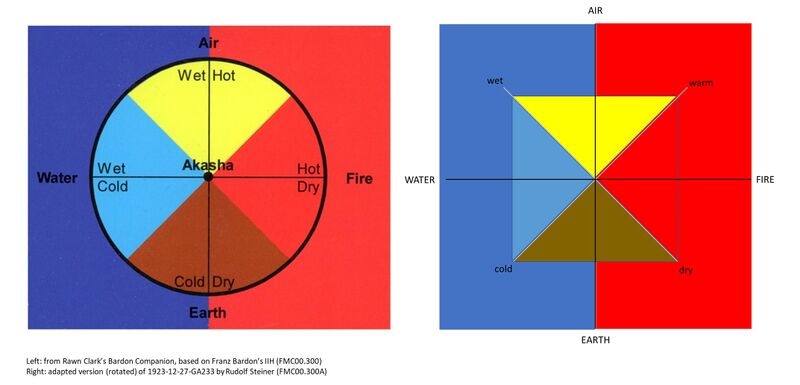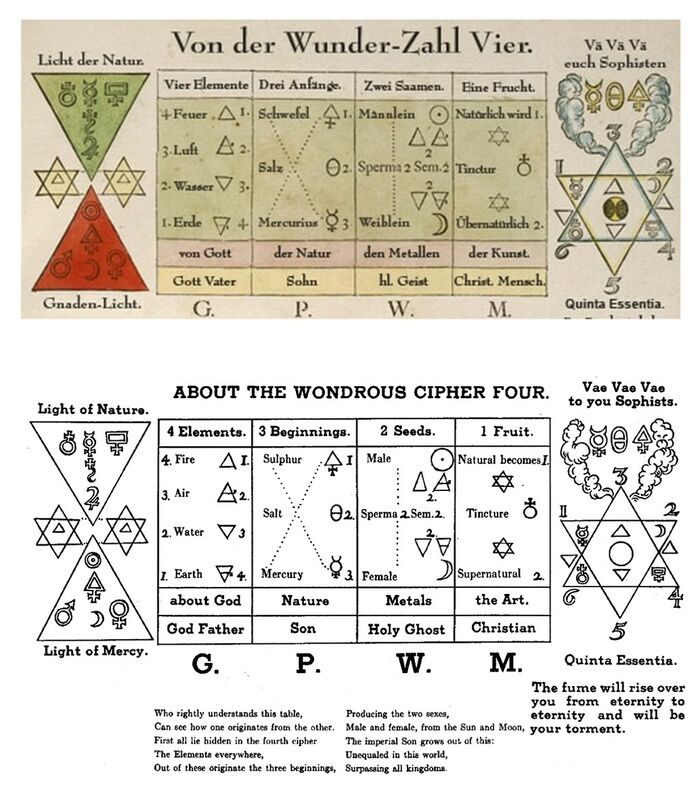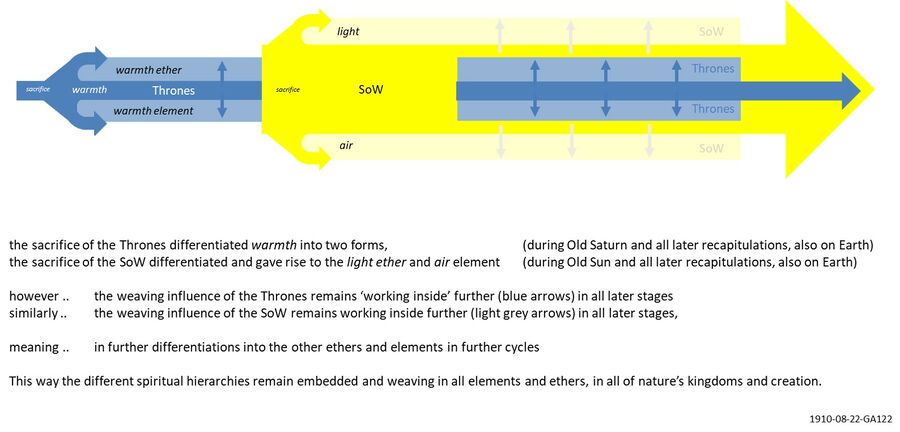Four elements
The four elements of warmth (or 'fire'), air, water and earth denote the spiritual substance created in the planetary system in previous planetary stages of evolution, together with the higher ethers. Each combination of a lower element and a higher ether arose from the sacrifice of spiritual beings who had reached a certain level of consciousness, whereby the sacrificed their lowest principle and emanated substance. See FMC00.225 and GA132.
The elements and higher ethers belong together, see Spectrum of elements and ethers, and are coupled by the etheric formative forces coming from the the elementary kingdoms (EK). How this hangs together is described in the Golden Chain, see Overview Golden Chain.
The four elements are therefore also principles, each with its own laws - see Four kinds of lawfullness (1921-06-24-GA205 and 1921-06-24-GA205), whereby the whole of physics part of our mineral science is only for the physical mineral element 'earth'.
Aspects
- link with the four chemical elements carbon, oxygen, nitrogen, hydrogen - see ao Schema FMC00.467 on Mineral kingdom
- unbalances of warmth and air (warmth and light ethers) called Luciferic influences, and water and earth (chemical and life ethers) called Ahrimanic influences
- elemental balance in Bardon's Initiation into Hermetics (IIH)
- link to the Human temperaments, depending on the dominant element
- Water
Illustrations
Schema FMC00.225 is a summary of the GA132 lectures that sketch - in imaginative pictures - the spiritual principles underlying the appearance of the elements and ethers. These principles (sacrifice, bestowal, renunciation .. ) and imaginations provide deeper meaning and understanding of the 'philosophical principles' of the elements and ethers, i.e. the working of the spiritual hierarchies. See 1911-10-31-GA132 to 1911-12-05-GA132.
Schema FMC00.300A shows the four elements: in the middle the original BBD by Rudolf Steiner, right a chalk drawing by one of the stenographers attending the lecture, and on the left a digital version in English.
Schema FMC00.300B shows the diagram by Rudolf Steiner as compared with Rawn Clark's version of the 'tetrapolar magnet' and the two 'electric and magnetic fluids' in IIH (as taken from A Bardon Companion). The diagram from 1923-12-27-GA233 (see Schema FMC00.300A was rotated and mirrored to get the same layout, and colours were added). See also and compare with The two etheric streams
Schema FMC00.149: gives a tabular synthesis showing the development of the Spectrum of elements and ethers and the development of our current Four kingdoms of nature as well as Man's developing Condition of Consciousness, see also Schema FMC00.583 on Man and nature's kingdoms in evolution
It shows how the plant and animal kingdoms evolved from the planetary stages of evolution: part of the development lagged behind and was not able to develop the next structural bodily principles, such as the astral on Old Moon, and the human 'I' on Earth.
Note: this schema has a Schema Commentary page, right click the schema number hyperlink to open in a new tab window.
FMC00.324 is an illustration from 'Secret Symbols of the Rosicrucians' (1780s), showing the four elements and the converging triangles on the left, and the relation with polarity: creating make and female from the Sun and the Moon. See also The two etheric streams
Schema FMC00.194: shows how during the preceding planetary stages (and recapitulations on Earth), the elements and ethers were created, in a way that the spiritual hierarchies all remain present in the totality of the whole spectrum of elements and ethers.
For another perspective, see also Schema FMC00.193 on Sacrifice and the narrative of 1911-10-31-GA132.
The illustration also makes the link with the thoughts of the archai on Old Saturn in the warmth element. The archai 'carried' this substance up to the Earth planetary stage when it became individualized in Man. (see 1925-01-11-GA026 on Development of the I#1925-01-11-GA026 (LT 144)
Lecture coverage and references
1723 - Anton Josef Kirchweger
The Golden Chain of Homer - Book I: Aurea Catena Homeri
The four so-called elements have been separated out of the Chaos, but they proceed all from one. The form is but one, and the matter is but one. The form is fire, and the matter is water.
The difference consists in their external appearance, by fermentation fire becomes air, and air becomes water, and water is become earth
But when fire is fixed by Art or by Nature it becomes earth, and when the earth is volatilised by water it becomes air and fire.
Because one element can be converted into the other, if this was not true they would differ centrally, but they do not.
The Chaos which produced these Elements was in the beginning fire and water only, these two have been divided into four by a further volatilisation and inspissation: By volatilisatian extennation or rarefaction.
Humidity becomes air animated by fire, but by condensation in inspissation of that Primordial Humidity the Earth has been formed with the fire turned downwards, toward the Center of the Earth. The Hieroglyphic characters of the Elements explain their nature exactly.
There is not a Subject under the Heavens, whether liquid or dry which does not contain this Universal fire, and Primordial Humidity.
The first is called Innate Heat, — the last is called Radical Humidity.
1909-05-06-GA057
When ancient initiates described their initiation they would say that after they had crossed the threshold they were first made acquainted with the activity of the elements. In olden times, “elements” was the name given to what today would be called physical conditions. That is, the solid, which was called “earth”; all fluids, which were called “water”; everything gaseous, which was called “air”; and everything to do with “warmth,” which was ascribed to the warmth ether and which was called an element.
Modern physicists deny all this. For them these four elements do not exist. For them there are from sixty to eighty elements, which have qualities. Under certain conditions one is fluid, another solid or gaseous. The condition of warmth belongs to all. What was described as an element in olden times does not exist today. There are now only qualities of things; the qualities have no existence of their own.
What today are called elements are actually only “real” in the coarse, tangible physical world. And what in olden times were called elements were understood not as reaching down into tangible matter itself, but only to the intangible, living activity of matter.
The world and “all that therein is” is born out of the spirit; man is born and called to rise to the spirit. Spiritual Science shows us more and more that the spirit lies exhausted in matter, that physical substance is the magic robe of the Spiritual. It is for man living in the material world, to charm the spirit out of this magic robe. The Spiritual finds its resurrection in man, in the human soul that rises above itself. — To enable the soul to find this path is the task of Spiritual Science. Thus does spirit find spirit. And man will realise and understand the spirit more and more as he fashions himself in its image.
1910-11-13-GA125
Empedocles possessed a modern spirit, but at the same time he was initiated in many different mysteries. He was clairvoyant to a high degree. Let us now imagine vividly that his modern way of thinking made him feel inclined to consider the world from a materialistic aspect; he has, in fact, drawn up a materialistic system which describes the world more or less from the stand point of a modern materialistic chemist, namely, as a combination and separation of elements. The one difference is that Empedocles distinguishes only four elements. He thought that various beings arise according to the way in which these four elements combine. As a result of these thoughts he felt the strong desire to discover in a true and real way what lies behind these material elements, what air and water really contain. If we peruse the Akasha Chronicle today and look into water, air, fire and earth we shall discover in them etherically the Christ. Empedocles could not find Him, but he felt the tremendous impulse to discover something in air and water, fire and earth, to find out what they really contain.
1921-06-24-GA205
the Greeks had four elements, for them the periodic table with chemical elements would only represent the single (mineral) element 'earth', and the physical only one lawfullness
1921-06-26-GA205
The human being and the elements (continuation of the lecture of 1921-06-24-GA205).
1923-12-15-GA232
less relevant reference, but interesting to see drawing in this lecture and compare with Schema FMC00.300 and variants
The pupil thus developed in reference to the world of nature a fine power of feeling for four qualities; in experiencing the warm air the feeling for warmth was developed in him, and at the same time a feeling for the element of air and its relation to warmth. Out of the coldness there developed the feeling for the difference between moisture and dryness; and he developed a delicate power of sensing these differences, because through these capacities of feeling he stood with the whole of his being in what the world offered.
...
Aristotle's pupil Alexander the Great had learnt of his own accord to feel what the climatic influences, what the winds carried from the north-west as the elements of cold and damp, and what the winds carried from the south-west as the elements of warmth and damp, but that, to him, was only one half of a world-feeling. This was amplified in his instruction, and there arose in his own inner being the idea that to this there belonged what drifted over from the north-east, the dry cold, and what drifted over from the south-east, the dry warmth.
Thus from the four directions of the wind he had learnt to distinguish the feeling of dryness, of warm dryness, of damp warmth, and of damp cold; and as a true man of that epoch he sought to reconcile these opposites.
1937-08-13-BD
Beinsa Douno talk 'The four rules', [translation by Annael]
Therefore,
- [the principle of] freedom refers to the soul,
- [the principle of] strength to the spirit,
- the principle of light to the mind, and the principle of goodness to the heart.
Without having a soul, the human being cannot be free; without having a spirit, he cannot be strong; without having a mind, there can be no light [for him], and without having a heart, he cannot be a good [person].
This very morning, you should examine your condition, see if you have freedom for your soul, strength in your spirit, light in your mind, and goodness in your heart. As you can see, the number four plays an important role in human life.
For this reason, Pythagoras taught his students the properties of the numbers: one, two, three, and four.
- In the concept of one, Pythagoras introduced hardness. By this, he wanted to say that one should be so hard that he is unmovable; that is, if he takes something in his hand -- even if the whole world begins to fight with him -- no one should be able to take it away from him. Hardness is a quality of the earth, of the solid matter.
- In the concept of the number two, Pythagoras introduced the quality of movement inherent in water. At the slightest slope, the water begins to descend and [passing through] this new environment, it begins to become acquainted with it. The human being must be mobile like water, to be willing to get to know the people he meets on his way and to study them. This is what it means, "a living human being", [namely] the one who can move on his own and be the master of himself.
- In the number three Pythagoras inserted the concept of expansion, which is characteristic of air.
- In the number four Pythagoras introduced the concept of penetration, which is a property of light.
Thus,
- the solid matter has one direction of movement [and tension]: downward, which is its weight.
- The liquid matter has two directions of movement [and tension]: downward and sideways.
- Air-like matter has three directions of movement [and tension]: downward, upward and sideways.
- Light, or fiery matter, has four directions of movement, four directions of tension.
Therefore, one cannot understand life, if he is not durable as the solid matter is, if he is not mobile like the water is, if he does not expand like air does, and if he does not penetrate like the light/fire/ does. To penetrate an object, it means to illuminate it.
Discussion
Related pages
References and further reading
see also Initiation into Hermetics (IIH) and Initiation exercises
- William R. Mistele: 'The four elements' (2019)
- Emil Stejnar: 'The four elements' (original in DE: 'Die vier Elemente')
- Johannes H. von Hohenstätten: Vertiefung der 4 Elementelehre des Franz Bardon (2015)






